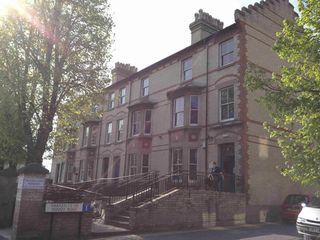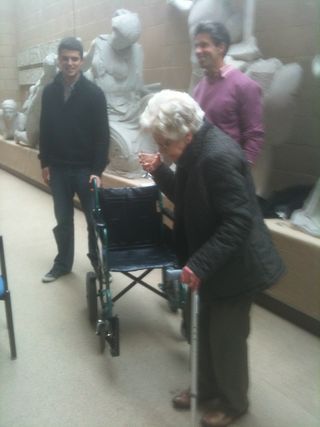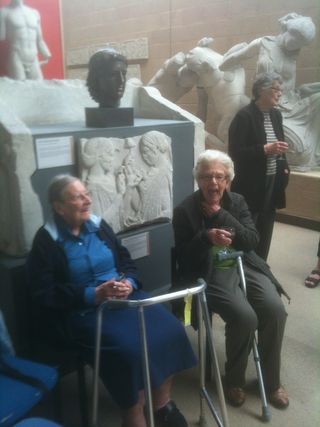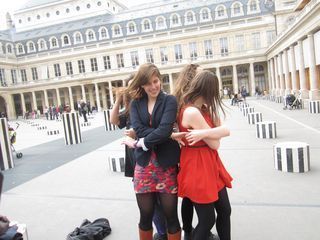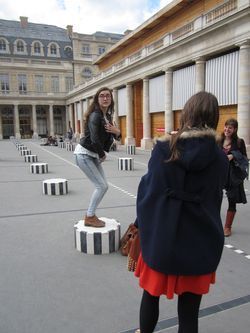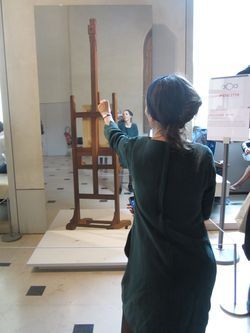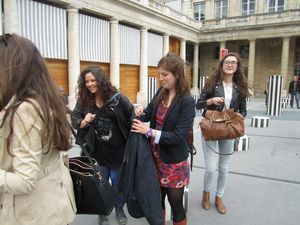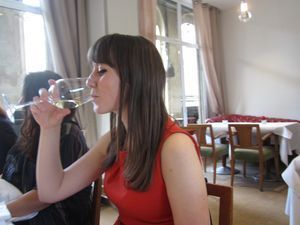Mary Beard's Blog, page 44
June 15, 2013
Does Latin have a future?
Last night was the last of the three events I've been "curating" with the British Museum: a debate entitled "Does Latin have a Future". The reason for this is obvious. Here we have a hugely successful exhibition on Pompeii and Herculaneum, but if we are going to go having people with interesting things to say about the history of these towns in the years to come . . . well, we'll need people who can understand Latin. Making sense of Pompeii is not all about excavation, after all; it's about fitting the physical remains into a bigger picture of the Roman world. And you can't do that without Latin.
Yet it's not entirely clear -- Gove or no Gove -- how committed to the subject any political party (or the "educational establishment" for that matter) really is. Currently about 12,000 people take Latin GSCE each year. That isn't much of a fall at all since the early 1990s, but there were 41,000 (including me I guess) taking the old O' level in 1970. (But if you really want to worry about the state of British foreign languages, reflect on the fact that only 57,000 took German GCSE last year.)
The trouble is that discussions of the future of Latin do tend to the self-congratulatory and/or complacent. I mean the people who decide that they want to go and hear an hour and a half's discussion on the future of Latin tend to be those who think it should have one; if you didn't, why waste your time? It's a bit like the people who buy books on The Death of Classics etc...they're not likely to be people who think it should be dead, making a triumphant purchase.
So we'd got together a group of panellists including some who weren't exactly friends of the subject. There was Donald Clark (whose blog posting "10 reasons NOT to teach Latin" is a tremendous broadside, busting some myths about the virtues of Latin that even I think need busting); and then there was David Aaronovitch who gave a lecture earlier in the year entitled "Teach Media Studies not Latin". That wasn't he explained what it was actually about, and he didn't invent the title himself anyway -- but he does have strong views about the part Latin plays in armoury of the fee paying educational, a gatekeeper between "us" and "them".
On the other side of the argument were Peter Jones, who has done more than anyone in the country to promote classical languages (including most recently being behind Classics For All, a charity which provides funds for getting Classics back into maintained schools). And, last but not least, Natalie Haynes, whom I used to teach and who is often on the radio and tv talking about Classics -- and was taking an evening off from reading a novel a day as Man Booker judge. (She herself is the author of The Ancient Guide to Modern Life -- about which, coincidentally, she was talking at the same festival at exactly the same moment as David was enthusing about Media Studies.)
In all kinds of ways the discussion went as I would have expected; and the arguments were careful. Noone claimed that learning Latin trained the mind, or that it helped you learn other languages. Peter carefully argued that learning Latin helped you examine and manipulate language carefully, which is a very different thing. And I threw in my pennyworth by saying that for me the fact that it was a dead language was a huge plus point: you didnt have to learn to ask for a pizza in it.
What came over most clearly -- and clearer than I had ever seen it before -- was the way we have projected onto Latin so many of our anxieties about privilege in education, teaching quality and the personality of the traditional teacher, ideas of utility, the control of the curriculum etc. Latin in other words is so much of a symbol that it is hard to discuss it without getting involved in series of much bigger debates, only symbolically connected with Latin.
David gave a sharp illustration of that when he claimed that if Latin were to be abolished by law, it wouldn't solve the privilege divide in British education. Instead another symbol would be found -- Eton would start teaching its kids Sumerian. (Don't, by the way, think that the whole occasion was comfortably lefty. One contribution from the audience suggested that Latin was good because it was what we taught our boys some of them> when we won the empire and were top nation.
But the real good news was that the audience wasnt actually dominated by people of my generation (nice as it was to see some mates). There were plenty of the younger generation -- including some who had taken GCSE Latin on that very day. Good luck all (and nice to see you Dr Challoner's!).
June 12, 2013
Congratulations to Boston Borough Council
I've just heard that Boston Borough Council has won the "overall impact award" at the annual Scrutiny Awards, for the work of its "task and finish group", which explored (and opened well-informed discussion about) the social impact of migrant workers coming into the area.
Amongst all the UKIP hysteria, and the "Boston Lincolngrad" hype, the local Council did some great work in looking carefully at the issue -- including producing a report that is well worth reading by anyone who is interested in current migration debates (and that should be all of us). It is a wonderfully measured report. It doesn't for a minute try to pretend that there are no problems; far from it. But it does also bust a large number of myths about the effects of migration on the area. As they say towards the start of the report:
"Opinion is hugely influence by what residents believe to be true and how this makes them feel. Evidence gathered during the review has on occasions contradicted 'local' viewpoints. 'Mythbusting' is limited in effectiveness and needs constant and repeated effort."
But just as important as the report itself, is the informed, community debate it prompted in Boston itself -- and for which the award citation specifically praises the council.
And me? I feel personally just a little bit gratified by this.
This was the report that I referred to . And it was from here that I drew some of my information about the state of public services in Boston (eg the high SATs score of the school with the highest proportion of non-English speaking kids, and the realatively low demand of migrants on the NHS).
Just one of the reasons I was ridiculed then (there were others!) was because I was supposed to have believed this report -- done, it was said, by a load of self serving local councillors wanting to whitewash the problems -- rather than the testimony of local eye witnesses.
I pointed out at the time that this was a cross party report, and that it included lashings of eye-witness testimony. I also felt inside that I had spent my whole life in the business of analysing tricky and biassed evidence, that I was reasonably confident of my ability to evaluate a document, and was absolutely confident that this report was a real class act, well argued, well documented and judicious.
OK, one prize doesn't prove me right, but all the same it is very gratifying indeed to discover the the Centre for Public Scrutiny thinks like I do on this one.
June 8, 2013
To curtsey or not to curtsey?
A few weeks ago I got an invitation to the opening of New Broadcasting House: a reception and the Queen and Duke were promised. I felt flattered and curious in about equal measure, so I said yes with some alacrity. I also thought that it would make a nice break in marking scripts (one of those breaks that actually speeds you up in the long run, rather than slowing you down).
It wasn't until I actually got to BH and was greeted with more enthusiasm than I thought I quite deserved, and whisked off to the Green Room, that I realised that I was down for the line up actually to meet Her Maj (now now longer, for obvious reasons, with the Duke). "You did know you were being presented, didnt you?" asked someone nicely. "Yes", I lied -- as it seemed the safest option. In fact after a moment's reflection I was glad I hadn't known. For despite my vaguely Republican sympathies (on which more later) I would certainly have spent a lot more time choosing the outfit, and getting the iron out and washing the hair etc etc. I was pretty pleased that it was just by chance I had donned the radical red tights, and sparkly gold espadrilles. (The tights are actually redder than they look in this photo, by the way.)
hair etc etc. I was pretty pleased that it was just by chance I had donned the radical red tights, and sparkly gold espadrilles. (The tights are actually redder than they look in this photo, by the way.)
When I got to the Green Room, it was clear that the line up had been chosen to represent the full gamut of BBC TV. I was at the pointy-headed end of the spectrum, which went through David Dimbleby, Fiona Bruce and Jenny Agutter, to the stars of Strictly (namely Tess Daly, Bruce Forsyth and Claudia Winkleman ). So far as I could tell most of us hadn't had a clue that we were to be on display.
The funny thing was, a team spirit quickly developed. It was all strangely democratising, a bit like being stuck in a lift. I mean, here were a load of people we would probably never otherwise have met, but -- like it or not -- we were all in it together. Happily too I was quickly joined by my mate Cassian Harrison,a one-time classicist, who had worked on the BBC end of Meet the Romans. I suspect that he had been steered in my direction by someone up the BBC foodchain who had wondered about quite how the sociality of this motley crew in the Green Room would work out. Would Brucie need rescuing from Beard (or vice versa)?
Until it was time for the line-up, we watched Her Maj touring the building on a large tv (whose channel setting proved a challenge even for the tv experts I was sharing with). Then, with what I infer must be the usual instructions ("Mam", not "Marm" etc), and the less usual one ("probably no need to commiserate on the health of the Duke"), we were led out to do our stuff. Our group (the "green group" -- with its slight whiff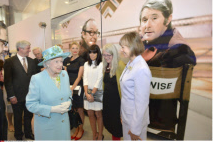 of the fun of the school trip) were placed in front of two large glossy photos of Eric and Ernie, and underneath a rather youthful David Attenborough. When she came by, I dont think I curtsied, but we shook hands. And Jenny and Claudia and I together talked to her about the building, about what Lord Reith would have made of it all -- and about the marvellous installation in the forecourt (World by Mark Pimlott) which plays a babel of BBC radio at you, in a variety of languages, as you walk over it, as well as displaying place names, subtly arranged, from the world over.
of the fun of the school trip) were placed in front of two large glossy photos of Eric and Ernie, and underneath a rather youthful David Attenborough. When she came by, I dont think I curtsied, but we shook hands. And Jenny and Claudia and I together talked to her about the building, about what Lord Reith would have made of it all -- and about the marvellous installation in the forecourt (World by Mark Pimlott) which plays a babel of BBC radio at you, in a variety of languages, as you walk over it, as well as displaying place names, subtly arranged, from the world over.
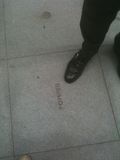 Then we all went off to the party, HM included, where a good time seemed to be had by all -- where I explored the tardis (above), and where I met (among others) Mark Pimlott himself.. And I captured his very foot next to "Pompeii" in World.
Then we all went off to the party, HM included, where a good time seemed to be had by all -- where I explored the tardis (above), and where I met (among others) Mark Pimlott himself.. And I captured his very foot next to "Pompeii" in World.
So did I enjoy it all? You bet I did and I still feel so pleased to have been asked. (Make the most of it, while you can Beard; a time is bound to come when people will say.. oh no, not her enthusing about the bloody Romans again -- yes, I know, some already do!) But how does all this fit with those "vaguely Republican sympathies"? If you claim to deplore hereditary privilege, how can you spend a great morning, all arranged around a minute's chat with an 87 year old monarch? Is it just hypocrisy?
Of course it might be; and I am probably the worst judge of that. But I don't think that it is quite so simple. In part, whatever your intellectual position, it's hard after nearly 60 years of watching this kind of thing on the telly, not to get a buzz from actually being there. To put that another way, when there's someone who's been part of your public world forever, it's hard not to be intrigued by actually pressing the flesh (or rather, the glove). But I suspect that there's quite a lot of the "stuck in the lift" phenomenon going on here. Part of what is so memorable is that "time out of time" feeling... of sharing something that you might never have planned, with people you haven't chosen, and would never expect to have met... and all getting along.
So thanks to all at the BBC for asking me and for hosting a damn good party. (And in case you're wondering about the exam scripts, it slowed them down rather than speeding them up. You dont play god with young peoples' futures after a morning, and party, like that.)
June 5, 2013
Satyrs, centaurs and centauresses
The husband and I have something of a weakness for buying modern objects on classical themes. One of our favourite (and cheapest) purchases was a (query) late nineteenth, early twentieth-century "fireside set" in the shape of a Roman legionary. Yes, it's a bit naff -- but we love it. Cheap, of course, because who else would want it?
Last weekend at our favourite local auction house we bought a couple of lead plaques with "classical heads". Actually (on the right, below) they turned out to be Napoleon and the lovely Marie-Louise, by the engraver Bertrand Andrieu. But they are displayed as many a Roman imperial couple, so -- so much the better.
Bertrand Andrieu. But they are displayed as many a Roman imperial couple, so -- so much the better.
But more intriguing was a firescreen (which we sort of needed, if you can ever actually need a firescreen) which we got for £70 and was decorated with a satyr, a centaur and centauress.
It's actually, as you can see from the picture at the top (and below), rather pretty. It's not at all posh. The images are simply stained on, they are not inlaid. But what date could it be, and (to ask the art historical question) what are the parallels?

Our view is that it cannot be post the second world war (no one surely had firescreens made with these classical themes after then, or even firescreens made at all). But how much earlier is it? The fact that it is fairly obviously mass produced made us think it was later rather than earlier. But the odd thing is that we haven't (after a bit of searching, but not comprehensive, to be sure) found a parallel on the web -- and if there were thousands made you'd expect that.
The other odd thing (as the husband observed) is that it is a rather odd shape for a firescreen. That is to say that a firescreen usually has a broad central panel and two narrow ones. This is the other way round. So is it another sort of screen. But what.
Any ideas? (It has had its hinges replaced, by the way -- but they appear to be in the same place as the originals.)
June 2, 2013
"Croydon of the Fens"?
This is a little story of new brutalism about to hit Cambridge -- and a cautionary tale of how "news" is made (and made up).
As anyone who has come top Cambridge by train recently will know, the area around the station is being redeveloped in a massive project, with hotels, office blocks, flats (and the UK's largest bike park) known as CB1 .This isnt the place to have a rant about this. Suffice it to say that it is drearily undistinguished architecture, and quite out of scale with the predominantly low rise Cambridge. (As station developments go, it's more London Euston than London St Pancras -- there's a taster on the right.)
go, it's more London Euston than London St Pancras -- there's a taster on the right.)
One of the casualties of this development may be a nice bit of nineteenth-century Cambridge vernacular architecture know as Wilton Terrace, which is a candidate for demolition. It was saved by the planning process once, but the developers have appealed. (There is a very balanced discussion of the issues here.)
Anyway, as I have a soft spot for this terrace (and a decidedly hard spot for CB1), I gave the campaign to save it (Friends of Wilton Terrace) a message of support:
“No good arguments have been put forward for the demolition of Wilton Terrace, which is a wonderful asset to the street scene at what is for many people their first approach to Cambridge. It is sad to contrast the brutalism of the cb1 development with this lovely bit of Cambridge vernacular."
They very properly asked if they could use it in their publicity and I said yes, of course.
They also contacted Gavin Stamp, who responded with some characteristic Gavin-prose:
"They are good examples of High Victorian domestic architecture, are sound and serviceable and deserve to survive. Clearly they stand in the way of the campaign to make Cambridge the Croydon of the Fens."
At this point things begin to go a bit awry.
A week or so after I'd sent off my quote, the Cambridge News had a front page notice (plus pic) saying that I had "joined the fight" to save the Terrace. Well true in a way, but I felt a bit guilty about this, as I had fired off a single quote, whereas other people had been devoting hours to the campaign.
Inside things got a little worse. The article quoted me and Gavin correctly, but got Gavin's name wrong (he became Camp!), and there was something about the way the article was laid out which meant that if you didnt read it carefully, it looked like it was me who had coined the phrase "Croydon of the Fens".
By the time it made the Telegraph, it was still just as accurate -- but somehow it looked even more like "Croydon of the Fens" was my coinage, especially when tweeted as "Mary Beard joins fight to stop Cambridge becoming "Croydon of the Fens".
At this point my wise assistant says, "This will be in the Croydon local press by this afternoon . . . it'll be "Prof attacks Croydon."
And sure enough, that is exactly what happened. And following the article in the Croydon Advertiser, the outrage of Croydon tweets was unleashed on me! Oh sh**, I thought. I get into scrapes when I speak my mind, but it is a bit rich to get lambasted for something you DIDN'T say. So I tweeted my affection for the lovely town of Croydon, and that it really wasn't me that said it! And fair enough the nice reporter did change the piece to make it clear. (Thank you!)
This is hardly much of a cause célèbre in misrepresentation. No one is going to be much the worse off for Beard having a wrong quote (sort-of) ascribed to her -- except for Beard having an uncomfortable 24 hours with the residents of Croydon. But it is a nice little object lesson in the Chinese whispers of news and Twitter -- and how even when you're not actually misquoted, a little story can take off entirely misleadingly.
At least, to give Twitter its due, it did allow me to squeal and say "it wasnt me".
May 29, 2013
What's the point of climbing Everest?
I have never entirely understood the point of climbing mountains. Mallory's famous old line (if he ever really DID say it) that he wanted to climb Everest "Because it is there" has never seemed to me quite enough. All kinds of things are "there" in the world, which we dont feel the need -- or think it worthwhile -- to conquer. Without want to pour cold water on the efforts of Ben Fogle, swimming the Atlantic has never been top of most people's "wish I could" list, and we would take it as a curious obsession if we met someone who wanted to climb every tree in the country (because they were there). For many people mountains are obviously different (climb every mountain?) and I wouldnt for a minute want to stop then doing it -- but it's not for me.
This may have something to do with the fact that both my parents were passibly keen mountaineers and rock-climbers. And I was dragged up many a Welsh peak at too early an age. It was the cost-benefit analysis that I couldn't ever quite figure. When you had done it, what did you actually get out of it? My Dad would always enthuse about "the view", but not many under-10s are great admirers of mountainous panoramas. Although the parents decried it as desecration, I rather liked Snowdon, because there was at least a café when you got to the top -- though equally I could never really see why we couldnt have taken the little train to the summit.
Add to that a few nasty fatalities among the parents closest friends (from "falling off"), and I think you'll understand why I'm none too keen.
Anyway this all came back to me this week -- as we were "celebrating" the 60th anniversary of the Ascent of Everest.
My Mum and Dad were quite good friends with some of the successful "ascent team", so I heard rather a lot about it all from them.
Even then I remember being puzzled at why the man who went up the mountain with Hillary didnt seem to have a proper name: I decided that Sherpa Tenzing (as he always was then called) might be the Nepalese equivalent of Corporal Jones, but that didnt seem to fit with all that talk about "the Sherpas" as if beasts of burden.
Now we listen to all the old footage again, the imperial style of the expedition and the reporting is perhaps the most striking thing of all -- and only 60 years ago. It's an exact stylistic match for a letter I found among my long dead Mother's papers. It's from Charles Evans, who was the deputy on the Everest expedition, written a couple of years later, after he had led the successful ascent of another Himalyan mountain, Kangchenjunga. It's typed with a red ribbon, on one of those old-fashioned aerogrammes, and this is was it says:
"Dear Roy and Sarah,
Just a line of greeting, which was meant to have been written to you high on the mountain, but I forgot the letter cards when I moved up myself.
You'll have heard by now that it is climbed. It was done twice on the 25th and 26th. Just to show the world that we had plenty of punch, and now everyone is down safely off it. The proceedings have however unfortunately been marred by the death of a Sherpa from cerebral thrombosis, a nice friendly chap and good worker, and the Sherpas view is 'We got the mountain', 'the mountain got one of us' . . .It is of course true that his death was a consequence of his being high, or most probably so.
We are recovering -- eating and resting -- should be in Darjeeling about June 10th, when most chaps seem to be going to the Alps. All the best
Yours ever, Charles."
I have no doubt that climbing this mountain (twice) was a tremendous feat of stamina, effort, bodily exertion and organisation. I also have no doubt (from everything my parents said) that Charles Evans -- a doctor, who went on to become a University Principal -- was a nice guy. But all the same there's something uncomfortable about the words, or at least of another era.
The bit that gets me is when he says that "everyone" is safely off the mountain -- and then you discover that "everyone" didnt include the dead, nameless Sherpa.
May 25, 2013
Ninetieth birthday parties
I suspect that if someone had told me thirty years ago that there were such things as ninetieth birthday parties, I would scarcely have believed them. It's not that I didn't realise that some people lived that long -- I just didnt imagine that they would still be in party mood.
Just how wrong can you be? In fact, my recent experience has suggested that the later "big birthdays" are rather more fun to celebrate than the earlier one. For a start, the drink is usually hugely better at the average seventieth than at the average twenty-first (even if Mummy and Daddy are paying). And also they dont tend to be full of people getting off with each other/not getting off with each other/ splitting up drunkenly etc. They are in other words rather more straightforwardly "fun".
Anyway, Cambridge people tend to be a long-lived breed, and I have had a good few ninetieths over the last decade or so. One of the most memorable was the celebration for Frank Walbank, the editor of Polybius (and on whom I have a few words to say in the next issue of the TLS).
The real shock on that occasion on that occasion was that the speech in honour of the birthday boy was given by his old Director of Studies, Bertrand Hallward, still then going reasonably strong. I remember walking away and thinking how weird it must be to reach ninety and still have your old teacher there and patting you on the head. It must feel like you'll never be allowed to grow up.
(The truth is MY old Director of Studies is still happily with us -- in the blue outfit above -- and in her mid-90s; though she'll be a venerable 120-something if she makes it to my own ninetieth, supposing I ever get that far).
Anyway, yesterday evening a whole group of us turned out for the ninetieth birthday of Greta Blake (she who is successfully wielding a stick and a glass of fizz above). Greta used to be the admin. secretary in the Museum of Classical Archaeology in Cambridge -- back when I was an undergraduate. And some of my friends had arranged a surprise party to mark the day.
It was of course a wonderful prompt to reminisce about the old days, when the sub-department Classical Archaeology had its own building, for the plaster cast collection, library and lecture room (which is now Peterhouse theatre, on the right). It's now all integrated with the Classics Faculty in the new building on the Sidgwick site.
the right). It's now all integrated with the Classics Faculty in the new building on the Sidgwick site.
Back then almost everything was different: you could smoke in the library (and indeed most of the teaching staff did); the museum assistants made drinks for those students taking Part II courses at coffee and tea-time; we patiently sat through more lectures on the "Alexander Mosaic" than anyone would now believe possible; and on Saturdays the middle-aged and vastly over-weight Hugh Plommer (who also had a quirky line as conservative rhymester) would take his favourite students, usually female, on car trips around local architecture (which, innocent as they were, would be frowned upon now).
It was over this rather colourful show that Greta presided from her typewriter (sic) in a room that doubled as office and library -- and about which we chatted among our cups last night, speculating as we went on just how long it had taken the vast Hugh P (yes, "Huge" of course was his nickname) to get up the stairs to to his garrett office.
And here is the best photo of him (who would be well over 90 himself now, had he lived....) I can find.
May 22, 2013
Can computers mark exams?
Blog followers will know that there is little is more reliably guaranteed to get Beard reaching for her lap-top than some new development in on-line learning. This is not (simply) because I am a nasty old Luddite. In fact I have become something of a convert to putting public lectures on-line. The events we've been launching at the British Museum, for example, in connection with the Pompeii exhibition are reaching thousands more people by being put on-line, and also reaching those who live miles away from London and could never get there in person. And that's great.
Not that there isnt a downside for the lecturer, mind you. Time was when you could give a public lecture or seminar more than once, in different parts of the globe. Now you'll find it's instantly podcast and you can't ever use it again. I mean, however value-added your actual presence is, you can hardly deliver to a group of people, whether they are paying or not, a talk that they could have through their computer at the click of a button. The result is -- since it takes (me at least) a lot of time to construct a new lecture -- that you end up going to fewer fewer places and doing fewer gigs.
But all the same, the balance still seems to me to come down on the side of new technology in the case of public lectures and events. That isn't the case for a lot of what is called on-line learning, and for the replacement of face to face instruction with some form of web-delivery.
If you want a frightening glimpse of the future, take a look at this article in the New Yorker, which heralds -- not-uncritically, I must concede -- the dawn of MOOCs: that is "Massive Online Open Courses". One of its lead characters is Greg Nagy, Professor of Greek at Harvard.
In fact, the article is well worth a read for anyone who wants a glimpse of the different styles in the US and UK academy. I dont think this description of Nagy -- "He wears the crisp white shirts and dark blazers that have replaced tweed as the raiment of the academic caste." -- will ring many bells on my side of the Atlantic. Crisp white shirts and dark blazers are not much in evidence in Cambridge, England.
But the reason for the article focussing on Nagy is his MOOC course on the "Concept of the Hero" (actually “CB22x: The Ancient Greek Hero") with its more than 31,000 enrolments. As soon as I read this, one side of me said "tremendous" at that: 31,000 takers for a Classics course. But then I read more carefully.
For a start, Nagy's description of how he has altered his university course for online consumption is a series of euphemisms for dumbing down. It now comes in bite-sized chunks:
"When he began planning his MOOC, his idea was to break down his lectures into twenty-four lessons of less than an hour each. He subdivided every lesson into smaller segments, because people don’t watch an hour-long discussion on their screens as they might sit through an hour of lecture. (They get distracted.) He thought about each segment as a short film, and tried to figure out how to dramatize the instruction."
And it is enlivened by staged debates with a couple of the production team pretending to be students:
"Nagy said he wanted to avoid “The Greg Show,” in which students saw only his talking head. When presenting Achilles’ kleos quandary, for example, he was sitting at a table with two members of his skunk-works team, Claudia Filos and Jeff Emanuel, both posing as students.
They nodded as he talked. Then Filos spoke up:
"So this one small passage, actually, has a lot to teach us about the whole epic tradition."
Nagy: "In a way, it’s a micro-narrative of the whole Iliad, Claudia. I couldn’t agree more.""
So, we are left to conclude, students at the non-online Harvard get real discussion, face to face. Online it is faked up for you, and you can communicate yourself via the message board.
When it comes to assessment, all you can do with so many takers is a series of multiple choice quizzes:
"‘Why will Achilles sit the war out in his shelter?’ Because ‘a) He has hurt feelings,’ ‘b) He is angry at Agamemnon,’ and ‘c) A goddess advised him to do so.’ 'No one will get this', . The answer is c).
But for the future, there is a whiff that computer grading of essays may be just around the corner:
"edX has been developing a software tool to computer-grade essays"
Even the president of Harvard, Drew Gilpin Faust, has to go to some lengths to state the obvious objections: “I think they are ill-equipped to consider irony, elegance, and . . . I don’t know how you get a computer to decide if there’s something there it hasn’t been programmed to see.”
But I also couldn't help wondering about cui bono -- or, rather, who's actually benefitting from this. This stuff tends to get hyped as a democratising move, to bring the great teachers out to a wider group of students. But there is obviously big money here. edX may be "non-profit", but money is very definitely on the horizon:
"Agarwal
May 18, 2013
Read a Latin Poem at the BM . . . and Pompeii coming to a cinema near you!
Our Latin poetry trio -- that's Peter Stothard, Llewelyn Morgan and me -- have had a regular gig at the Cheltenham Literary Festival for some years now on "how to read a Latin poem in Latin". The format is basically this.
We choose a bit of Latin text .. we've done Horace, and Virgil, and Juvenal in the past .. we put it onto a handout and a powerpoint with a literal "interlinear" translation, and we take the audience through it, explaining how the poetry work IN LATIN. Sure, we give a bit of background etc, situate our poets in their cultural and political context, but the main aim is to explore how the language and metre works. What's amazing is that it works, and even people who know little or know Latin seem to get a real lot out of it.
We each have our different roles in the line up. Peter is the guy who keeps us firmly on track -- and reminds us from time to time to STICK TO THE TEXT. Llew is the real expert literary voice, and the "metre man" (he will explain to even the most sceptical why the absence of a caesura in line 22 makes all the difference). And I am somewhere in the middle.
Anyway last night we ventured -- with some trepidation -- to take our road show to the British Museum. The poet we had chosen to get the treatment was Virgil.
It was a tie in event with the Pompeii and Herculaneum exhibition. There are in fact almost 40 quotes from Virgil's Aeneid scrawled on the walls of Pompeii. But, as we pointed out, some two thirds of them are actually the first lines of Aeneid Book 1 and Aeneid Book 2: arma virumque cano, and conticuere omnes. They are classic quotes in other words -- and dont necessarily mean that large numbers of the Pompeian population had read the poem cover to cover (as it were). They are rather like "to be or not to be", a phrase which hundreds and thousands have scrawled on walls and desks, without ever having opened a text of Hamlet.
So the text we chose last night were the first dozen lines of each of those books, starting from the classic quotes. And the question was, what MADE those words so memorable. OK, it is partly the simple fact that they are the opening words of the books; but there has to be more to it than that -- not all opening lines go viral, even in the most renowned works of literature ("If music be the food of love" yes ... "Tush never tell me" (Othello), no).
My part of the answer was to stress how arresting and surprising the words must have been on first hearing, before they had become weighted down with "classic" status, and so treated a bit too reverently. "Arma virumque cano" must have sounded like the most over the top, self-confident, in your face, bit of boasting you could get from a poet. (Read: I am going to do both the Iliad and the Odyssey in one, and just look at the that first person singular in cano). And Llew was brilliant on why conticuere omnes hit the spot much more powerfully that "they all fell silent" (the compound, the tense, the instantaneity . . . )
I think a good time was had by all, and it will soon be on-line so the rest of the planet can listen if they are so minded.
There are more Pompeii and Herculaneum events coming up at the BM, by the way -- AND outside. In fact there is a great and brave experiment I'm involved with on June 18th, to bring a broadcast from the exhibition to local cinemas -- getting up close to the objects, plus some backstory from the ruins of Pompeii and Herculaneum themselves. (For Cambridge types there are still some seats left at Cineworld -- grab 'em).
May 14, 2013
Newnham in Paris -- and a surprising Michelangelo
It was our Newnham finalists' annual trip to Paris on Saturday (and this blog comes with heartfelt thanks to all those who have made this event possible with their generous donations). As I have said on previous years, it's a long day: leave Cambridge just after 5.00, onto the 7.30 Eurostar, 90+ minutes in the Louvre before lunch (see the mille feuilles above.. NOT, let me stress, paid for by donor money), then another 90+ minutes in the museum, then a drink in a café, then back on the train, knackered. Participants were all our college finalists, plus me and Francesca Martelli who has been a lecturer with us for a year but is now (sadly for us, happily for her) going off to be Assistant Prof at UCLA.
There really isn't a better way of cheering yourself up before the final exams, as well as seeing some really  good visual and archaeological material that you might never have seen before. We had (as often) a great talk together about the Louvre Hermaphrodite. What is the point of this figure which is a female from one side and a male from the other? I was trying to argue that it was not just a clever joke, but an attempt much more fundamentally to challenge the foundations of how you can judge what you see... Francesca tried to push us to consider how flimsy its male characteristics were, no more than a little willy (and so what does that say about masculinity?).
good visual and archaeological material that you might never have seen before. We had (as often) a great talk together about the Louvre Hermaphrodite. What is the point of this figure which is a female from one side and a male from the other? I was trying to argue that it was not just a clever joke, but an attempt much more fundamentally to challenge the foundations of how you can judge what you see... Francesca tried to push us to consider how flimsy its male characteristics were, no more than a little willy (and so what does that say about masculinity?).
We had some hard museum work (including more mythical discussion about Marsysas, while those who had just done their own dissertations sought out images of Athena and of Nero).Then lunch was a nice treat, and it was followed by some poses of classical sculpture in the Palais Royal (more revision in a way -- that's the Tetrarchs above, and on the right Aphrodite whacking Pan with her slipper.
the Tetrarchs above, and on the right Aphrodite whacking Pan with her slipper.
And then back to the Louvre. At this point some of us explored an exhibition cleverly dispersed through the museum of work by Michelangelo Pistoletto (part of the Arte Povera movement in Italy in the late 20th century). I had foolishly failed to spot that
 this was on, but my eyes lit up when I realised, because in the book on classical art that I wrote with John Henderson we had featured his "Venus with Rags" (left) -- suggesting that Pistoletto was trying to show that both throw away rags and throw away Venuses are part of the waste products of the West.
this was on, but my eyes lit up when I realised, because in the book on classical art that I wrote with John Henderson we had featured his "Venus with Rags" (left) -- suggesting that Pistoletto was trying to show that both throw away rags and throw away Venuses are part of the waste products of the West.
There were plenty of Pistoletto's to discover in the Louvre. It was fun, but I am afraid to say that none were quite as good and the Venus with Rags. Pistoletto had a nice line with mirrors, trying to break down the temporalities between the museum object and the museum viewer.. putting the visitor into the frame, as you can see with Francesca on the right. But he did tend to do it over and over again, till even I felt like saying -- OK, I have GOT THE POINT.
line with mirrors, trying to break down the temporalities between the museum object and the museum viewer.. putting the visitor into the frame, as you can see with Francesca on the right. But he did tend to do it over and over again, till even I felt like saying -- OK, I have GOT THE POINT.
All the same it was great to see his stuff close up and great to be there with the students, who got a huge amount out of it (basically it was education at its most hands on). A privileged lot you may say we are. But it wasn't the privilege of personal wealth. No student paid more than a train fare back from London to Cambridge, and we were the beneficiaries of the donors who had seen how valuable such an outing can be. Thank you all.
And here's a few more photos....
Mary Beard's Blog
- Mary Beard's profile
- 4110 followers






